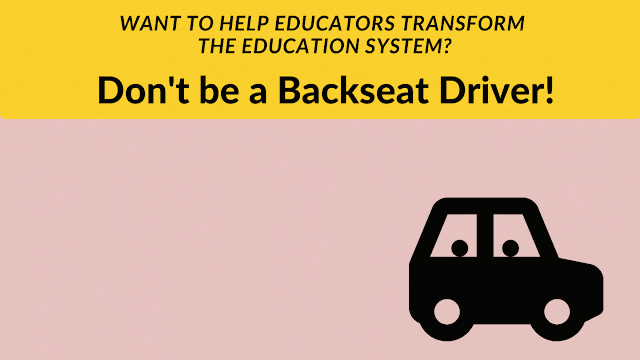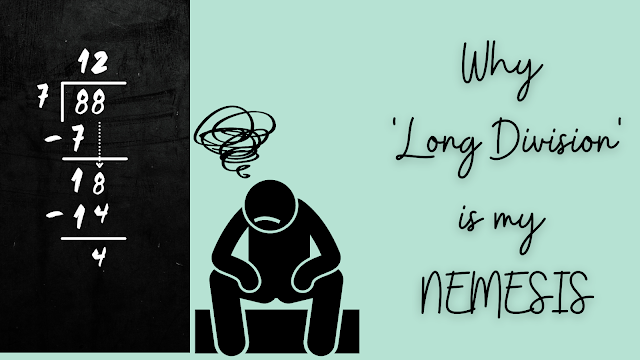Patient Optimism in Education
The Idea: Patient Optimism is important for anyone striving for Transformation in Education. Change in this complex context is more likely to be incremental, and brought about by the advancement of both - technology and thriving communities, together.
Here are 5 ways to nourish Patient Optimism:
- Come back to your vision and purpose often - Use your long term vision to remind yourself and team WHY you do what you do everyday.
- Recognize the power of compounding in learning communities - it will help delay gratification and help you stay strategic and focused
- Stay consistent in action - important, lasting changes happen incrementally more often than dramatically/ disruptively
- Be realistic and reasonable about hassle - Be realistic about the context and develop some tolerance for hassle, it will help you continue steadfastly in the face of inevitable hinderance
- Make change visible - do your best to make both incremental and long term change visible to your team
After 15 years in education, I am convinced that Patient Optimism is essential for any lasting change in education. Why?
Is Technology Disrupting Education?
My take is that technology is leading to educational transformation - yes, but not disrupting immediately. Change is slow and steady, not swift. Hand-in-hand with communities of educators, not turning education around from the sidelines.
The last decade has been filled with promises for ‘disrupting education’ through innovation, particularly in technology. In my opinion, these innovations - MOOCs - EdX, Coursera, Udemy, Khan Academy; Algorithm guided learning programs like Lexia Core5, Zearn Math, BYJU’s, Duolingo; Peer-to-peer learning platforms like Scratch Programming - have been incredible and I have gained personally and professionally from each of these.
In 2010, I discovered KhanAcademy. It had a huge impact on how I was able to differentiate for learners and also how I was able to help teachers with developing mathematical content knowledge.
In 2013, I did my first MOOC - Jo Boalers ‘How to Learn Math’. It. blew. my. mind. (50% was discovering the MOOCs but also 50% was discovering Jo Boaler’s awesomeness - which is a whole other blog post). It helped me take my self-directed professional learning to a whole new level. In 2014, I took on my first leadership role and my voracious consumption of MOOCs played a huge part in building my competence.
In 2017, I discovered Zearn Math. This was the first algorithm guided Math program that impressed me because of its phenomenal user interface and pedagogical approaches - two things that were lacking in the ones I had previously explored.
In 2017, I also started to use Scratch for coding (coincidentally, I used a MOOC on Scratch in 2018 with my students). Now in 2021 Google’s CS First Curriculum has helped us upgrade this Scratch Coding experience with students.
The above Edtech list has some of the important influences on my learning and it is just the tip of the iceberg. Along the way I also discovered life-changing Google Workspace Tools and a plethora of teaching tools (Kahoot, peardeck, quizziz… the list is endless).
While there is no denying that these innovations have been phenomenal (and I am a very passionate EdTech advocate), I agree with Justin Reich’s position in his book ‘Failure to Disrupt’, that they have not led to any ‘disruption’ in education as a system, yet. High Schools have not gone fully online with flexible hours. MOOCs have not disrupted college education in a significant way yet even though leaders predicted this would happen in the last decade.
The context for educational change is complex, a mix of people, practice and policy - multiple stakeholders, public-private overlap, simultaneously goals of equity, quality, innovation and entrepreneurship in education. And as with most slow moving, complex systems change - even the paradigm shifts are more likely to be incremental, understated changes - noticeable over time, rather than swift, dramatic ones. And this change will happen with advancing technology and advancing human potential i.e. learning communities, hand in hand.
Which is why… Patient Optimism.
Patient Optimism
In a previous blog post I listed important takeaways from Justin Reich’s ‘Failure to Disrupt’ and the term he used - ‘Patient Optimism’ were perfect words to describe the long term orientation needed for anyone striving for educational transformation.
When I exercise Patient Optimism, it is sometimes confused with a defeatist mindset of a person jaded by experience. It is not.
What does Patient Optimism mean?
Patient:
- Long-term view on change
- Resilience to delay gratification and withstand many uncontrollable and inevitable setbacks
Optimism:
- Belief that it is possible to transform education for the better with effort
- Motivation to keep fighting the good fight
Ways to nurture Patient Optimism
1. Come back to your vision and purpose often
Going back to your vision and purpose regularly helps you (and your team) remember WHY you do what you do everyday. It reminds you of your purpose and helps build a long-term orientation. Having purpose keeps you and your team motivated. Having a long-term orientation helps you make more strategic choices towards your goals.
Without purpose you might be able to run a sprint, but not the marathon. Transforming education is a marathon.
2. Recognize the power of compounding in learning communities/ cultures of innovation
I recently read the best-selling book ‘The Psychology of Money’ by Morgan Housel - which was a fantastic read. I am sure the author intended for it to have very little to do with education, but somehow I came away with many first principles that I found applicable to my work in education. This point (compounding) and the next two (consistency, optimal hassle), have all been inspired by comments in his book and his discussions on the Tim Ferris podcast.
The power of compounding - something that starts small, but after it accumulates and passes a critical threshold, its exponential increase leads to massive impact. Morgan Housel explains ‘the Power of Compounding’ in wealth using Warren Buffet as an example. We saw the (not so happy) power of compounding in nature with the coronavirus. Malcolm Gladwell talked about the power of compounding in his book ‘The tipping point’.
These compounding principles seem to hold true when you aim to transform education by building robust Learning Communities. Housel speaks of compounding wealth, in education I related this to ‘compounding Learning Communities’. In the beginning, there is a strong 'change inertia' and the sphere of influence for change is small. Impact of change is too small to feel tangible. But with committed effort, over time as more people are influenced, more change old habits and influence others with their new learning, over time a critical mass is reached. And if you are patient enough until you get to the tipping point, you will enjoy the massive, self-perpetuating benefits of compounding in your organisation.
Transforming Education is a mammoth endeavour. One that is unlikely to be achieved without the full force of compounding learning communities/ cultures of innovation.
3. Stay consistent with effort
This is a simple idea - stay consistent in your effort.
Here are some statements from many wise/successful people:
'Impatient with actions, patient with results' - Naval Ravikant
'The professional does not wait for inspiration; he acts in anticipation of it' - Steven Pressfield
‘The knowing-doing gap’ - Pfeffer and Sutton
‘Turn your ‘(I’ll do this) someday into (I’ll do this) Monday’ - Our VIA21 Google Certified Innovator Trainer, Beth
'The magic of the creative process is that there is no magic. Start where you are. Don't stop.' - Seth Goden
Consistency is key, for any long term gains. This simple truth has been shared a million times over but in the age of hitting 100k views or 1 million dollars in start up funding or 1 million sales super fast, it is hard to practice ‘Impatient with effort, patient with results’
Without consistent effort, neither the endurance nor compounding necessary for educational transformation can be achieved.
4. Be resilient and realistic about hassle
This is the third idea I borrowed from Morgan Housel, who writes about the ‘Optimal tolerance for Hassle’. In order to have resilience and stay consistent in your effort towards your vision, it is important to have a realistic outlook on the way ahead. Challenges and inconvenient hassle is inevitable. We know this, but it is so easy to lose perspective when we are tested.
For educational transformation, be realistic about what to expect along the way - if your tolerance for hassle is too low, you will be miserable and your patience may run out; but don’t allow your tolerance for hassle to be high enough for a defeatist mindset to creep in.
5. Make change visible
The thing about having a patient, long-term outlook is that we may not notice incremental but important changes happening all the time.
Seeing successes, even small ones, is motivating. Track and share all little wins - they help us stay steadfast in our effort towards our long-term goals. When you are running a 42km marathon, helping the team notice that you have gotten through the first 10k, strong, is valuable.
Since transforming education is a mammoth endeavour and the path is slow and winding, we must take stock of the small moves forward. Or with time we may feel overwhelmed by the challenge and less patient and less optimistic.
I will leave you with this wonderful post from Seth Godin - 'How Change Happens' with a similar message, but of course articulated much more eloquently!
.png)
.png)



Comments
Post a Comment